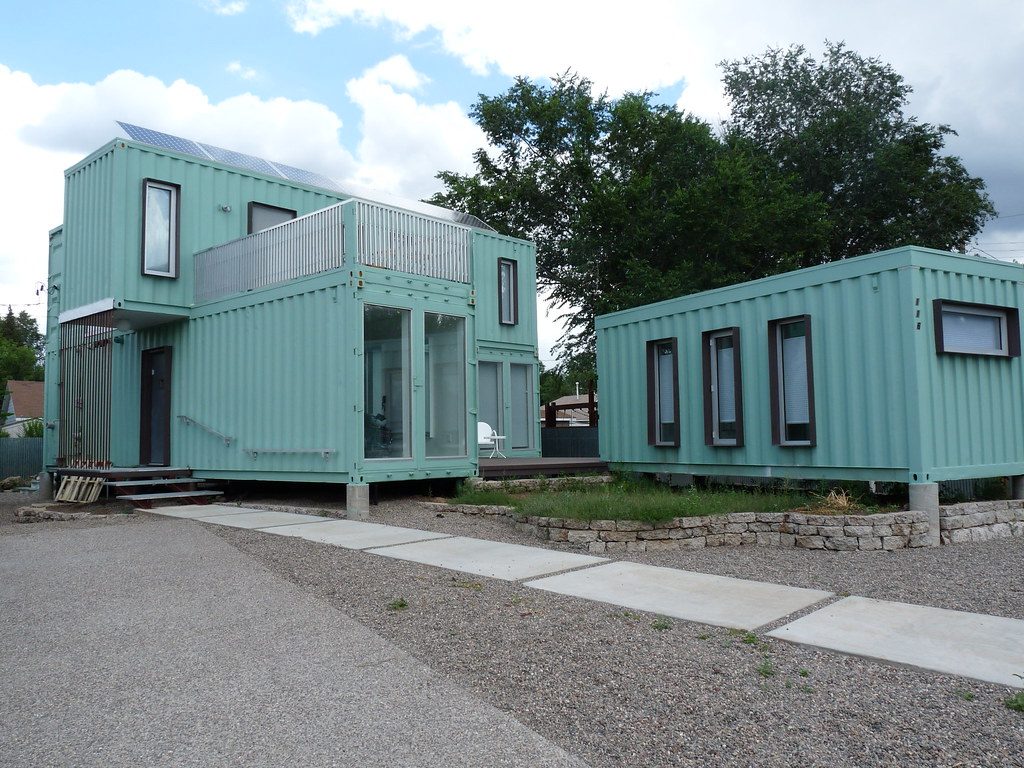Shipping container architecture has evolved as a form of architecture using steel intermodal containers (shipping containers) as structural element, because of their inherent strength, wide availability and relatively low expense. A container is often referred to as a TEU, or twenty-foot equivalent unit. A standard TEU is approximately 20 feet long and 8 feet wide. The most common height is 8 feet 6 inches, an ample ceiling height.
Currently, an estimated 21,000 shipping containers arrive in the United States every day. Retired shipping containers are abundant in the United States. Port authorities estimate that over 700,000 used shipping containers are stockpiled on prime waterfront real estate without a significant use, purpose, or typical method for disposal, making them ideal construction modules.
Cargo containers are a rather perfect sized box for building. Made of steel and wood, this product is stronger than conventional framing, stackable for creating levels and is readily available.

Shipping containers have been called an ideal building material as they are designed to carry heavy loads and to be stacked in high columns. They are also designed to resist harsh environments – such as on ocean-going vessels or sprayed with road salt while transported on roads. As all shipping containers are made to standard measurements and as such they provide modular elements that can be combined into larger structures. Construction involves very little labor. As they are already designed to interlock for ease of mobility during transportation, structural construction is as easy as stacking more containers. Containers can be stacked up to 12 high when empty. They also keep building costs way down. Containers may be purchased from major transport companies for as little as US $1,200 each. Even when purchased brand new they are seldom more than US $6000.
Many structures based on shipping containers have already been constructed, and their uses, sizes, locations and appearances vary widely. In 2000, the firm Urban Space Management completed the project called Container City I in the Trinity Buoy Wharf area of London. The London docklands development is composed of environmentally friendly work studios and live/work lofts stacked on top of each other to create a 5-story building.
Architects created a flexible design system that relies on component pieces instead of units. Instead of using a 1 container = 1 unit approach, their system relies on components in various permutations to create very livable, adaptable spaces. Aside from the Container City residential project, the system has been used in projects as diverse as classrooms, office spaces, residential units, retail spaces and even youth centers.
“Containers as architecture are just one of the ways in which we can look at objects and find new uses to them. The modular nature of the containers, their adaptability, and the fact that they can be found in industrial surplus make them an ideal prefab material,” noted Urban Space Management.
Another southern California architect designed the first two story shipping container home in the U.S. as an approved structural system under the strict guidelines of the nationally recognized Uniform Building Code (UBC). This home was the Redondo Beach House and it inspired the creation of Logical Homes, a cargo container based pre-fabricated home company.
Containers are also used in disaster relief. In 2011, an earthquake in Christchurch, New Zealand devastated the city’s central business district. The Cashel Mall reopened in a series of shipping containers within months. The use of rudimentary containers to ship cargo began in the late 17th century. By the 1950s, the U.S. military standardized their design, building strong, uniform, theft-resistant, stackable shipping containers that were easy to load and unload by truck, rail and ship, and easy to store. Now, containers are not just for shipping anymore. In the future, the cargo container will contribute to construction in a variety of ways.